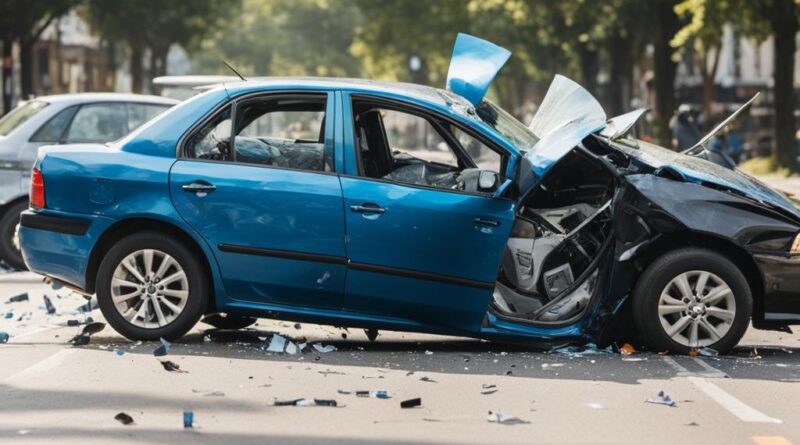Hit While Reversing? Your Next Moves After a Car Crash
Reversing accidents can be a stressful and confusing experience. When you’re hit while in reverse, it’s important to know what steps to take to protect your rights and seek compensation for damages. Understanding fault determination, following proper procedures, and seeking legal guidance can significantly impact the outcome of your situation.
Key Takeaways:
- Assess the situation and prioritize your safety after being hit while reversing.
- Determining fault in a reversing car accident may involve considering factors such as negligence, speeding, and state laws.
- State laws and comparative negligence principles vary, affecting fault assignment and compensation amounts.
- After a reversing car accident, gather evidence, exchange information, seek medical care, and notify your insurance company.
- Preventing backing up accidents involves installing a backup camera, staying alert, and educating children about vehicle dangers.
Determining Fault in a Reversing Car Accident
When involved in a reversing car accident, fault is typically assigned to the driver who was reversing. This is because it is their responsibility to ensure the path is clear before proceeding. However, there are situations where the other driver may be at fault, such as if they were negligent, speeding, or distracted.
“It’s important to note that fault assignment in reversing accidents can be influenced by state laws and comparative negligence.”
State laws vary when it comes to determining fault in car accidents. Comparative negligence laws, for example, can impact how fault is assigned by taking into account the percentage of fault assigned to each party involved.
Here is a list of factors that may affect fault assignment in reversing accidents:
- The driver who was reversing bears primary responsibility for ensuring the path is clear.
- If the other driver was negligent, speeding, or distracted, they may be deemed at fault.
- State-specific laws and comparative negligence principles play a role.
It’s essential to consult with legal professionals who specialize in car accidents to fully understand the factors that can impact fault determination in reversing accidents.
| Factors Affecting Fault Assignment in Reversing Accidents | |
|---|---|
| Determining Fault | Assigning fault to the driver who was reversing. |
| Driver Negligence | Consideration of other driver’s negligence, speeding, or distraction. |
| State Laws | Impact of specific state laws on fault assignment. |
| Comparative Negligence | Application of comparative negligence principles. |
Understanding the factors involved in fault determination for reversing accidents can help drivers protect their rights and seek appropriate compensation for damages.
Fault Laws in Car Accidents
Fault laws in car accidents can vary significantly from state to state. Understanding these laws is crucial for determining liability and seeking compensation. In this section, we will explore the concept of fault in car accidents, the role of comparative negligence, and how the percentage of fault affects the compensation individuals can receive.
Fault in Car Accidents
In many states, including Illinois, fault is a key factor in determining which party is responsible for compensating the other party involved in a car accident. In an at-fault state like Illinois, the driver who is primarily at fault for the accident has the legal obligation to compensate the other party for damages.
“In an at-fault state like Illinois, the driver who is primarily at fault for the accident has the legal obligation to compensate the other party for damages.”
Fault determination in car accidents is typically based on various factors, such as evidence from the accident scene, witness statements, police reports, and any applicable traffic laws. It is essential to collect and document as much evidence as possible to support your claim.
Comparative Negligence
Comparative negligence is a legal principle used in some states to determine the level of fault assigned to each party involved in an accident. Under comparative negligence, fault can be shared among multiple parties based on their respective contributions to the accident.
The percentage of fault assigned to each party directly impacts the amount of compensation they can receive. For example, if you are found to be 20% at fault for the accident, your compensation may be reduced by 20%.
“Comparative negligence is a legal principle used in some states to determine the level of fault assigned to each party.”
It’s important to note that not all states follow a comparative negligence system. Some states have adopted a modified comparative negligence rule, where a party can only recover damages if their degree of fault falls below a certain threshold, typically 50% or 51%.
Understanding Fault Laws
Since fault laws and regulations can vary by state, it’s crucial to familiarize yourself with the specific laws in your jurisdiction. Consulting with a knowledgeable attorney who specializes in car accident cases can provide valuable guidance and ensure you understand your rights and legal options.
Remember, fault in car accidents is a complex and often disputed matter. Seeking legal advice from a professional can help you navigate through the legal process and protect your interests.
Next Steps After a Reversing Car Accident
After a reversing car accident, your immediate priority should be your safety and wellbeing. Here are the essential steps to take:
- Assess yourself for injuries: Check yourself for any visible injuries or pain. If you feel severe pain or suspect a serious injury, avoid moving and wait for medical assistance.
- Move to a safe area: If it’s safe to do so, move your vehicle to the side of the road or a nearby parking lot to avoid obstructing traffic.
- Call 911: Dial emergency services to report the accident. Provide them with accurate information about the location, any injuries, and the number of vehicles involved.
- Cooperate with the police: When the authorities arrive at the scene, cooperate fully by giving them a detailed account of what happened. Stick to the facts and avoid speculating or accepting blame.
- Exchange information: Exchange contact, insurance, and vehicle information with the other driver(s) involved in the accident. Note down their name, phone number, driver’s license number, license plate number, and insurance details.
- Gather evidence: Take photos of the accident scene, including the vehicles involved, their positions, and any visible damages. Additionally, gather contact information from any witnesses present and note down their version of events.
- Seek medical care: Even if you feel fine initially, it’s important to seek medical attention as some injuries may not be immediately apparent. Prompt medical evaluation will document your injuries and provide necessary treatment.
- Notify your insurance company: Report the accident to your insurance company as soon as possible. Provide them with accurate details and follow their procedures for initiating a claim.
- Consider legal representation: Depending on the circumstances of the accident and the severity of your injuries, it may be beneficial to consult with a car accident attorney. They can guide you through the legal process, protect your rights, and help you seek compensation for damages.
Remember, each car accident is unique, and the above steps offer general guidelines. It’s essential to consult with legal and medical professionals for advice specific to your situation.
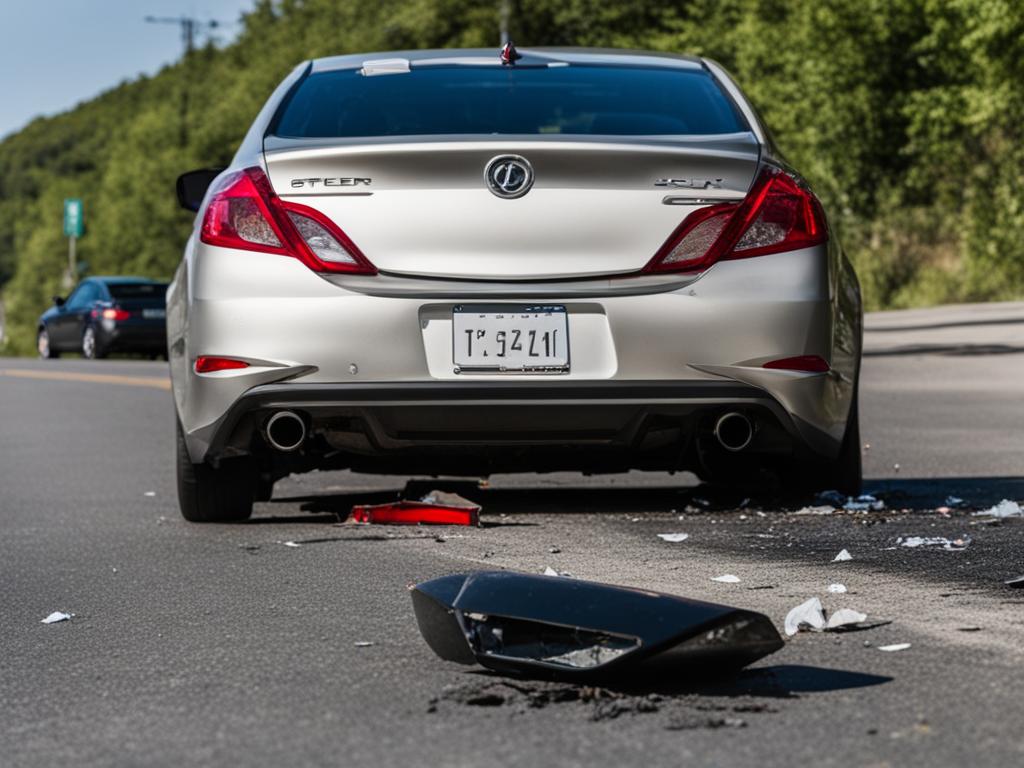
Factors in Determining Fault in Backing Up Accidents
When it comes to determining fault in backing up accidents, several factors come into play. The driver who had the right of way and followed traffic patterns is typically not at fault. However, there are other considerations to be taken into account.
- Location of damage: The position of the damage on both vehicles can provide important clues about the sequence of events and help determine fault. For example, if the damage is mostly on the front of one vehicle and on the rear of the other, it suggests that the driver in the front vehicle may bear more responsibility.
- Witness statements: Eyewitness accounts can provide valuable insights into what actually happened during the accident. Witness statements can help corroborate or challenge the narratives of the parties involved and play a significant role in establishing fault.
- Violation of traffic laws: If one driver violated traffic laws, such as speeding or running a red light, it can affect fault determination. Even if the other driver was backing up, the driver who violated traffic laws may bear a greater share of the blame.
It’s important to note that the driver who was backing up is often considered partially or entirely responsible for the accident. However, exceptions exist if the other driver was negligent, reckless, or violated traffic laws. Ultimately, fault determination in backing up accidents requires a thorough investigation and consideration of all relevant factors.
Example of Damage Location:
| Vehicle 1 | Vehicle 2 |
|---|---|
| Rear-end damage | Front-end damage |
Top Causes of Backing Up Accidents
Backing up accidents can occur due to various reasons, leading to serious consequences on the road. Understanding the root causes can help drivers take preventive measures and minimize the risk of such accidents. The top causes of backing up accidents include the following:
1. Driver Inattention
One of the primary causes of backing up accidents is driver inattention. Distractions inside the vehicle, such as mobile phones, conversations, or eating, can divert the driver’s attention from the road. Failing to focus on the surroundings while reversing increases the likelihood of colliding with objects, vehicles, or pedestrians.
2. Obstructed Views
Obstructed views play a significant role in backing up accidents. Objects, structures, or vegetation can block the driver’s line of sight, making it difficult to detect potential hazards behind the vehicle. Limited visibility greatly increases the risk of collisions, especially in tight spaces or congested areas.
3. Poor Vehicle Design
The design of certain vehicles can contribute to backing up accidents. Vehicles with large blind spots or limited rear visibility pose challenges for drivers when it comes to identifying objects or pedestrians behind them. This is particularly true for larger vehicles like pickup trucks and SUVs.
4. Distractions
Distractions both inside and outside the vehicle can be a major factor in backing up accidents. Loud noises, movement, or distractions caused by passengers or nearby activities can divert the driver’s attention, leading to delayed reaction times and potential collisions.
5. Blind Spots
Blind spots are areas around the vehicle that are not visible to the driver, even with the use of mirrors. These blind spots can make it challenging to detect objects or people behind the vehicle while reversing. Drivers must take extra precautions and use additional methods, such as turning their heads and checking blind spots, to ensure their surroundings are clear.
Comparison of Causes of Backing Up Accidents
| Cause | Description |
|---|---|
| Driver Inattention | Distractions inside the vehicle divert the driver’s attention from the road. |
| Obstructed Views | Objects, structures, or vegetation block the driver’s line of sight. |
| Poor Vehicle Design | Vehicles with large blind spots or limited rear visibility pose challenges for drivers. |
| Distractions | Loud noises, movement, or distractions inside or outside the vehicle divert the driver’s attention. |
| Blind Spots | Areas around the vehicle that are not visible to the driver, even with the use of mirrors. |
Understanding the causes of backing up accidents highlights the need for increased awareness, cautious driving, and taking necessary precautions to ensure the safety of oneself and others on the road.
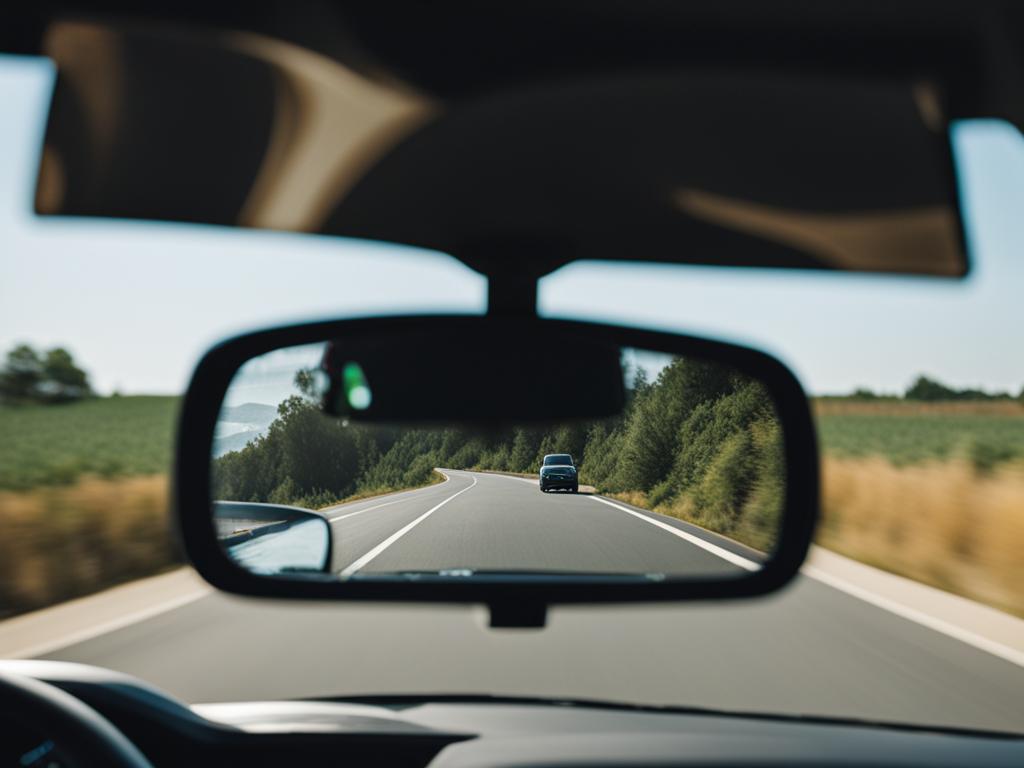
Key Factors in Backing Up Accident Fault Determination
When it comes to determining fault in backing up accidents, several key factors come into play. One crucial consideration is the right of way. If both vehicles involved in the accident were in motion, the driver who failed to yield and violated traffic patterns may be at fault. This is because drivers have a responsibility to follow established traffic rules and ensure a safe environment for all road users.
However, if only one vehicle was in motion at the time of the accident, the driver of that vehicle is typically held responsible for the collision. This is because, as the moving vehicle, they have a higher duty of care to avoid potential hazards, including other vehicles, pedestrians, or objects in their path. It is their responsibility to exercise caution and take necessary precautions before proceeding.
Of course, there can be exceptions to these general guidelines. If the other driver involved in the accident was reckless, exhibited aggressive behavior, or was overall negligent in their actions, they may share a portion of the fault for the accident. Additionally, if the other driver was speeding or violated any traffic laws, it can impact the determination of fault in the backing up accident.
In such cases, it is crucial to gather evidence, such as witness statements, photographs of the accident scene, and any available video footage, to support claims and provide a clear understanding of the events leading to the accident. This evidence can help establish liability and protect the rights of the injured party.
Comparative Negligence and Fault Allocation
It is also important to note that fault allocation in backing up accidents may be subject to comparative negligence laws, which vary by state. Comparative negligence allows for the assignment of fault based on the percentage of responsibility each party bears for the accident. In some cases, both drivers may be found partially responsible for the collision, depending on their actions and level of negligence.
To better understand fault determination in backing up accidents, let’s explore a hypothetical scenario:
| Scenario | Fault Allocation |
|---|---|
| Driver A is reversing out of a parking space while Driver B is driving through the parking lot. | Driver A: 70% Driver B: 30% |
| Driver A is reversing out of a parking space while Driver B is speeding through the parking lot. | Driver A: 10% Driver B: 90% |
In the first scenario, Driver A, who was reversing, shoulders the majority of the fault (70%) since they failed to yield to the oncoming vehicle. However, Driver B also bears some responsibility (30%) for not exercising caution while driving through the parking lot.
In the second scenario, the fault allocation shifts significantly due to Driver B’s negligent behavior of speeding. Driver A is now only assigned 10% of the fault, while Driver B is accountable for the majority (90%) for their reckless actions.
These examples demonstrate how comparative negligence and the circumstances surrounding the accident can impact fault determination in backing up accidents. It is crucial to consult the specific laws and regulations in your state to understand how fault allocation may be determined based on the unique circumstances of your case.
Ultimately, accurately determining fault in backing up accidents requires a thorough evaluation of the situation, including an examination of each driver’s actions and adherence to traffic rules. Seeking legal guidance from a car accident attorney can provide valuable support and ensure that your rights are protected throughout the legal process.
Who Is At Fault in Parking Lot Accidents When Backing Up?
Parking lots are common settings for backing up accidents. Accidents can occur when a car backs out of a parking space, posing risks to parked cars and moving vehicles. Determining fault in parking lot accidents requires careful consideration of various factors.
When a car backs out of a parking space into a parked car, the driver who was backing up is usually at fault. It is the responsibility of the backing-up driver to ensure that the path is clear before proceeding. However, there are situations where the parked car may share some degree of fault. If the parked car was illegally parked and obstructed visibility, fault may lie with the illegally parked car.
On the other hand, when a car backs out into a moving car, the driver who was backing up is typically at fault. This is because the driver backing up has the duty to yield to other vehicles and pedestrians. However, there can be exceptions to this general rule if the other driver was speeding or not paying attention.
Examples of Fault in Parking Lot Accidents
Let’s consider some examples to understand the fault allocation in parking lot accidents:
Example 1: A driver is backing out of a parking space and collides with a parked car. The backing-up driver is usually at fault for not ensuring the path was clear.
Example 2: A driver backs out of a parking space and hits a moving car in the parking lot. In this case, the backing-up driver is typically at fault for failing to yield to the moving car.
Example 3: A driver backs out of a parking space and collides with a speeding car. In this scenario, both drivers may share fault – the backing-up driver for failing to yield and the speeding driver for exceeding the speed limit.
To determine fault accurately in parking lot accidents, it may be necessary to assess the location of damage, review witness statements, and consider any relevant traffic laws and regulations.
Avoiding Parking Lot Accidents
To minimize the risk of parking lot accidents when backing up, drivers can take preventive measures:
- Always check surroundings and use mirrors before entering the vehicle.
- Be alert and avoid distractions while reversing.
- Consider installing a backup camera to improve visibility and eliminate blind spots.
- Educate children about the dangers of playing near parked vehicles and supervise their outdoor activities, especially in parking lots.

| Fault Scenario | Driver Backing Up | Parked Car | Moving Car |
|---|---|---|---|
| Backing out into a parked car | At fault | Typically not at fault | Not applicable |
| Backing out into a moving car | Typically at fault | Not applicable | Depends on the circumstances |
Preventing Backing Up Accidents
To minimize the risk of backing up accidents, drivers can take preventive measures. Here are some important steps to consider:
-
Install a backup camera: Installing a backup camera can eliminate blind spots and greatly improve visibility while reversing. This technology allows you to see objects or pedestrians behind your vehicle that may not be visible in the rearview mirrors alone. Make sure to choose a camera with high resolution and wide-angle coverage for enhanced safety.
-
Check surroundings before entering the vehicle: Before getting into your car, take a quick walk around it to check for any obstacles or potential hazards in your path. This can include children, pets, bikes, or other vehicles. By being aware of your surroundings, you can avoid potential accidents when reversing.
-
Stay alert and avoid distractions: When reversing your vehicle, it’s crucial to stay focused and avoid distractions. Keep your full attention on the task at hand, such as checking your mirrors, using your backup camera, and listening for any warning sounds from your vehicle’s sensors. Avoid distractions like using your mobile phone or adjusting settings while reversing.
-
Educate children about the dangers: Children are particularly vulnerable to backing up accidents. Take the time to educate them about the dangers of playing near parked vehicles and the importance of staying away from moving vehicles. Supervise outdoor activities involving cars and establish clear boundaries to prevent accidents.
By following these preventive measures, drivers can reduce the risk of reversing accidents and increase safety on the road. Remember that prevention is key when it comes to avoiding unnecessary collisions.

Importance of Blind Spots in Backing Up Accidents
When it comes to backing up accidents, blind spots play a critical role in increasing the risk of collisions. Regardless of the use of rearview and side mirrors, every vehicle has areas that remain hidden from the driver’s line of sight.
Blind spots obstruct the driver’s ability to detect objects or pedestrians behind the vehicle, potentially leading to dangerous situations. The limited visibility in these areas makes it essential for drivers to take extra precautions when reversing.
Being aware of blind spots can significantly reduce the chances of accidents while backing up. By understanding the specific areas that are not visible through mirrors alone, drivers can adjust their movements and ensure the surrounding environment is clear before proceeding.
To enhance visibility and minimize blind spots, using additional safety features such as rearview cameras or sensors can be highly beneficial. These technologies provide visual assistance by displaying a live feed of the area directly behind the vehicle, allowing drivers to detect any potential obstacles that may be in their blind spots.
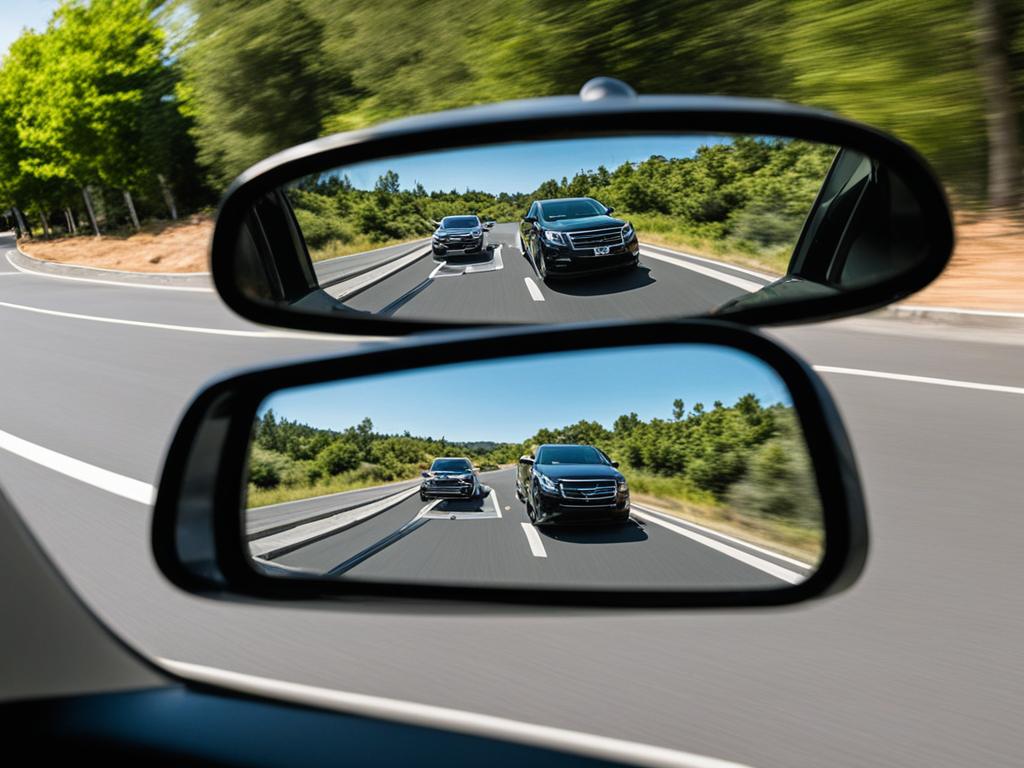
Backing Up Accidents: How Rearview Mirrors Can Help
Rearview mirrors are a driver’s essential tool for monitoring their surroundings while reversing. When used effectively, rearview mirrors can help minimize blind spots and improve overall safety.
“Rearview mirrors are a vital component of any vehicle, providing drivers with essential visual information. They serve as an additional line of sight, especially when checking blind spots that may not be visible through other means.”
When adjusting rearview mirrors, it’s important to position them correctly to maximize visibility. The Society of Automotive Engineers (SAE) recommends the following mirror settings:
- The rearview mirror should be adjusted to display the center of the rear window.
- The side mirrors should be angled outward to minimize blind spots and provide a seamless visual transition when checking the surroundings.
| Benefits | Disadvantages | |
|---|---|---|
| Rearview Mirrors |
|
|
When using rearview mirrors, it’s important to remember that they are not foolproof and should be used in conjunction with other safety measures. Drivers should always physically turn their heads to check blind spots and use the appropriate signals to indicate their intentions while reversing.
Backover Accidents and Their Risks
Backover accidents, where a person is hit by a vehicle in reverse, present serious risks. These accidents can occur in various settings and often result in fatalities or injuries, particularly among children. Large vehicles like pickup trucks and SUVs are commonly involved. Understanding the risks associated with backover accidents can emphasize the importance of prevention and caution when reversing.
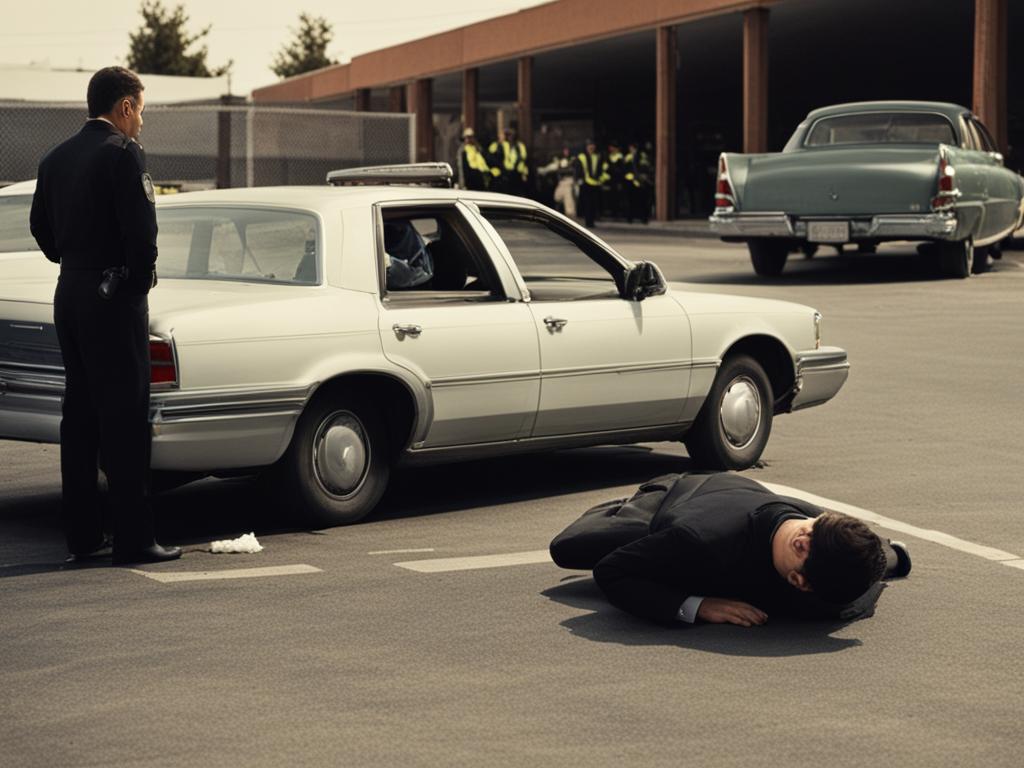
| Risks of Backover Accidents |
|---|
| Injuries to Pedestrians: Backover accidents can cause severe injuries to pedestrians, especially children who may not be easily visible to drivers. These injuries can range from broken bones and internal organ damage to traumatic brain injuries. |
| Fatalities: Unfortunately, backover accidents can be fatal, especially when the accident involves a large or heavy vehicle. The impact of being hit by a vehicle in reverse can cause fatal head injuries or crush injuries. |
| Blind Spots: Blind spots behind vehicles can prevent drivers from seeing pedestrians or objects in their path when reversing. These blind spots increase the risk of backover accidents, especially if the driver does not take extra precautions. |
| Vehicle Design: Some vehicle designs may have larger blind spots or limited visibility, increasing the chances of a backover accident. SUVs and pickup trucks, due to their larger size and elevated height, are more likely to have significant blind spots. |
| Driver Distractions: Distractions such as cell phone use, in-vehicle entertainment systems, or driver inattention can significantly contribute to backover accidents. Taking your attention off the road while reversing can have severe consequences. |
Prevention Tips
- Install a backup camera to improve visibility and reduce blind spots.
- Be vigilant and check your surroundings before entering the vehicle.
- Avoid distractions while reversing, such as using your phone or adjusting the radio.
- Teach children about the dangers of playing near parked vehicles and always supervise their outdoor activities.
- Double-check for pedestrians or obstacles behind your vehicle before reversing.
- If possible, choose vehicles equipped with advanced safety features like rearview cameras and blind spot detection systems.
“Prevention is key when it comes to backover accidents. Taking simple precautions and staying aware of your surroundings can save lives and prevent devastating injuries.”
Steps to Take After Being Hit While Reversing
If you have been involved in an accident while reversing your vehicle, it’s crucial to follow specific steps to protect your rights and seek compensation for any damages. By taking prompt action, you can ensure that you are prepared for the legal and insurance processes that follow.
- Assess your injuries: First and foremost, check yourself for any injuries. If you or anyone else involved in the accident requires immediate medical attention, call 911.
- Move to a safe area: If possible, move your vehicle to a safe location away from traffic to prevent further accidents or injuries.
- Call emergency services: Contact the appropriate emergency services, such as the police or paramedics, to report the accident and request assistance.
- Speak with the police: When the police arrive at the scene, provide them with a detailed account of what happened. Be honest and provide accurate information to the best of your ability.
- Gather information: Collect vital information from the other parties involved in the accident, including their contact details, insurance information, and vehicle registration numbers. You should also gather contact information from any witnesses present at the scene.
- Document the scene: Take photographs of the accident scene, capturing the positioning of the vehicles, any damages sustained, and any relevant road markings or traffic signs. These photos can serve as essential evidence later on.
- Seek medical care: Even if you don’t have obvious injuries, it’s crucial to seek medical attention as soon as possible. Some injuries may not be immediately apparent, and a medical professional can document any injuries you may have sustained in the accident.
- Notify your insurance company: Report the accident to your insurance company promptly. Provide them with all the necessary details and cooperate fully with their investigation.
- Consult with a car accident lawyer: It’s advisable to consult with a qualified car accident lawyer who specializes in personal injury cases. They can guide you through the legal process, help protect your rights, and assist you in seeking the compensation you may be entitled to.
Following these steps can ensure that you are taking the necessary actions to protect yourself after being hit while reversing. Consulting with a car accident lawyer can provide you with the expertise and support needed to navigate the complex legal proceedings and seek the compensation you deserve.

| Steps to Take After Being Hit While Reversing |
|---|
| Assess your injuries |
| Move to a safe area |
| Call emergency services |
| Speak with the police |
| Gather information |
| Document the scene |
| Seek medical care |
| Notify your insurance company |
| Consult with a car accident lawyer |
Conclusion
Being involved in a reversing accident can be a highly stressful experience. However, understanding the next steps to take and your rights can empower you during this challenging time. By determining fault accurately, following proper procedures, and seeking legal representation when necessary, you can significantly increase your chances of obtaining justice and recovering compensation for any damages incurred.
It is crucial to prioritize safety and prevention to minimize the risk of future backing up accidents. By being diligent, staying alert, and taking advantage of available technologies like backup cameras, drivers can contribute to safer roadways and protect themselves and others on the road.
In summary, if you find yourself in a reversing accident, remember to assess the situation, gather necessary information, seek medical care for injuries, report the incident, and notify your insurance company. Additionally, consulting with a car accident attorney can provide valuable guidance and support throughout the legal process. By taking these important steps, you can navigate the aftermath of a reversing collision and work towards a resolution that protects your rights and interests.
FAQ
What should I do if I am hit while reversing?
After being hit while reversing, assess yourself for any injuries and determine if it’s safe to move. Get to a safe area and call 911 to report the accident. Cooperate with the police, exchange information with the other driver, and gather evidence by taking photos and talking to witnesses. Seek medical care for any injuries and notify your insurance company. Consider hiring a car accident attorney to guide you through the legal process.
Who is usually at fault in a reversing car accident?
In most cases, the driver who was reversing is considered at fault in a reversing car accident. It is their responsibility to ensure the path is clear before proceeding. However, the other driver may be at fault if they were negligent, distracted, or violating traffic laws.
How are fault laws in car accidents determined?
Fault laws in car accidents vary by state. In at-fault states, the driver primarily at fault is responsible for compensating the other party. Comparative negligence laws also come into play, where fault can be shared among multiple parties. The percentage of fault assigned to each party determines the amount of compensation they can receive.
What should I do after a reversing car accident?
After a reversing car accident, prioritize your safety and wellbeing. Assess yourself for any injuries and determine if it’s safe to move. Get to a safe area and call 911 to report the accident. Cooperate with the police, exchange information with the other driver, and gather evidence by taking photos and talking to witnesses. Seek medical care for any injuries and notify your insurance company. Consider hiring a car accident attorney to guide you through the legal process.
What factors are considered in determining fault in backing up accidents?
Factors considered in determining fault in backing up accidents include the driver who had the right of way, followed traffic patterns, the location of damage, and witness statements. The driver who was reversing is often considered partially or entirely responsible, but exceptions exist if the other driver was negligent or violated traffic laws.
Why do backing up accidents occur?
Backing up accidents can occur due to driver inattention, obstructed views, poor vehicle design, and distractions. Blind spots, areas not visible to the driver, can make it challenging to detect objects or people behind the vehicle. These accidents are particularly dangerous for children, and large vehicles like pickup trucks and SUVs are often involved.
Who is usually at fault in parking lot accidents when backing up?
In parking lot accidents where a car backs out of a parking space into a parked car, the driver who was backing up is typically at fault. However, if the parked car was illegally parked and obstructed visibility, fault may lie with the illegally parked car. When a car backs out into a moving car, the backing-up driver is usually at fault, unless the other driver was speeding or not paying attention.
How can I prevent backing up accidents?
To minimize the risk of backing up accidents, drivers can take preventive measures. Installing a backup camera can eliminate blind spots and improve visibility. Checking surroundings before entering the vehicle, staying alert, and avoiding distractions while reversing are important. Educating children about the dangers of playing near parked vehicles and supervising their outdoor activities can also help prevent accidents.
Why are blind spots important in backing up accidents?
Blind spots play a significant role in backing up accidents. Every vehicle has areas that the driver cannot see, even with the use of rearview and side mirrors. These blind spots can hinder the driver’s ability to detect objects or people behind the vehicle, increasing the risk of accidents. Being aware of blind spots and taking extra precautions when reversing can help prevent collisions.
What are backover accidents and their risks?
Backover accidents occur when a person is hit by a vehicle in reverse. These accidents can happen in various settings and often result in fatalities or injuries, particularly among children. Large vehicles like pickup trucks and SUVs are commonly involved. Understanding the risks associated with backover accidents emphasizes the importance of prevention and caution when reversing.
What steps should I take after being hit while reversing?
After being hit while reversing, it’s important to take specific steps to protect your rights and seek compensation. Assess your injuries, move to a safe area, call emergency services, speak with the police, gather information, document the scene, seek medical care, notify your insurance company, and consult with a car accident attorney to navigate the legal process.

